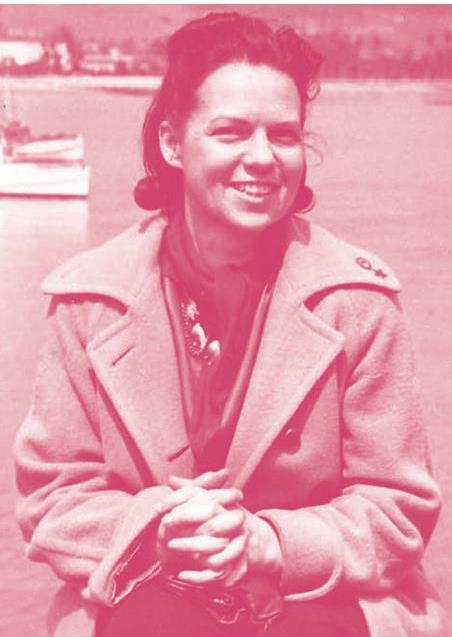Meet the Woman Who Invented Cosplay遇见角色扮演之母
2021-05-18珍妮弗·卡尔普周坤
珍妮弗·卡尔普 周坤

Myrtle R. Douglas, otherwise known as Morojo, rarely gets the credit she deserves for the worldwide phenomenon. 角色扮演如今風靡世界,然而默特尔·R.道格拉斯,亦唤作Morojo,却功劳未彰。
With its focus on fashion and creative craftsmanship, cosplay provides a path into fandom for young women, and once theyre inside, it makes them highly visible. Wearing their fannish devotion quite literally on their bodies, contemporary female cosplayers pay a lovely tribute to the woman who invented their hobby—though they probably dont realize it, as her massive contribution to pop culture has largely been forgotten by history.
Myrtle Rebecca “Morojo” Douglas Smith Gray Nolan was a Gemini, born in June 1904. She was an atheist, an active member of the Los Angeles Science Fiction Society, and a proponent of the 19th-century constructed auxiliary language Esperanto, meant to foster communication and understanding between people of all cultures.
Between the years of 1938 and 1958, she edited three separate long-running sci-fi fanzines (“editing” including all of the typing, mimeo, and physical work required to manufacture the zines, naturally) and wrote editorials for several major early sci-fi “pro”-mags in the early 40s. Basically she was the mid-20th century equivalent of a prolific, influential blogger. She married three times, had one son, and shared a decade-long romantic and creative relationship with fellow fan Forrest J. Ackerman, with whose help she sparked off a phenomenon that would develop into costume-loving fan culture we know today. In the decades following her death, her memory has largely been resigned to footnotes designating her a mere “girlfriend,” and thats a damn shame, because both with and without Ackerman Morojo was a badass.
Though they never married, Morojo and “Forrie” spent over a decade together. Active in the Los Angeles Science Fiction Society, the couple collaborated on the production of an eight-year, 50- issue run of the clubs official zine Voice of the Imagi-Nation as well as their own fanzine Novacious. Morojos affection for Ackerman was so great that she paid him tribute in her nickname.1 Morojo and “4E” (4E = Forrie = Forrest) sometimes even used a joint Esperanto name on projects they created together, like some sort of pre-digital proto-blogger couple with a shared social media account.
For more than 10 years Morojo and Ackerman were an inseparable, intellectually compatible dream duo, and 1939 was an especially big year for the pair: they started their first major zine together, jointly financed the publication of teenage Ray Bradburys first sci-fi zine, and attended the first-ever World Science Fiction Convention (Worldcon) wearing “futuristicostumes” straight out of the 1936 H. G. Wells movie Things to Come—the first fan costumes ever worn in recorded history.
Morojo and Ackerman shook the newly developing geek culture to its core with those costumes, laying the foundation for a hobby that would become a majorly significant expression of fandom before the 20th century was out. But heres the thing: while towering Ackerman made a great model for his costume, he had nothing whatsoever to do with its construction. Both of the costumes were envisioned, designed, and laboriously hand-made by Morojo! Forrie deserves partial credit for the invention of cosplay, sure: he was a grown man who boldly wore a shiny space cape through the streets of New York in 1939. And what the hell, well presume that they thought up the idea of wearing costumes to the con together—it would be ungenerous to suppose otherwise. But Morojo! Morojo was the person who single-handedly brought fantasy into real physical space when she created and wore her own costume. Given modern cosplays intense focus on individual creativity and craft, its bizarre that Ackerman is the one most often credited as being the O.G. cosplayer in fan literature. Morojo, who made the futuristicostumes, deserves the bulk of the credit.
To crush the next few decades of history into a single sentence: the idea of dressing up like your favorite fictional characters caught on and gained traction. After 1939, costume contests became an annual tradition at Worldcon, drawing more and more participants with each passing year. Morojo herself wore at least two more costumes to subsequent cons: in 1941, an A. Merritt-inspired frog face mask designed and created by the then young and unknown visual effects master Ray Harryhausen, and in 1946 another Merritt-inspired “Snake Mother” ensemble, which reportedly “created a sensation.” But time passed quickly. New fans enthusiastically embraced the costume custom without really wondering about its origins. Nobody in the tight-knit sci-fi fan community bothered to explain its provenance to outsiders. When Japanese writer Nobuyuki Takahashi visited Worldcon Los Angeles in 1984 and coined the term “cosplay” to describe the experience to readers back home, Morojo had long been forgotten.
The fan costume hobby she had initiated exploded, though, becoming wildly popular in Japan. The brand-new baby internet increased ease of cross-cultural communication and the fire coming out of Japan spurred costume-wearing Western fans to step up their craft. Cosplay blazed through the geek fandoms that had sprung up in the wake of sci-fi, staking territory in fan groups devoted to fantasy, anime, comics, and gaming. It was unstoppable, and no amount of craven comment section misogyny or inappropriate leering at cons could turn the tide.
Morojo had faded from memory, but the path she hacked into early sci-fi circles lead thousands of girly geeks into fandom.
The ending of Morojos own personal tale is less unambiguously cheerful. Superfans arent always fated for eternal love, and Morojo and Forrie broke up in the mid-40s. Morojo didnt split from sci-fi fandom when she parted ways with Ackerman, however; she remained active in the L.A. sci-fi scene throughout the 1940s, publishing her own Esperanto-focused fanzine Guteto from 1941 until 1958.
Later, in an unbelievably fabulous late-life narrative twist, the Mother of Cosplay decided to spend the last decade of her time on Planet Earth indulging “a love of the nudist movement.” She lived out this costumeless dream with her third and final husband in the high desert of Southern California.
Morojo, who so loved a language created in attempt to linguistically unite the entire world, would have probably loved the internet. And Morojo, “a vociferous opponent of the Exclusion act,” sexism, and racism in early fandom, would have loved to know that the “futuristicostumes” she made in 1939 would ultimately lead to the development of a more diverse, welcoming fan community than she might ever have imagined in her own time. The next time you cosplay, remember Morojo, the first woman who ever donned a costume to march into a con. With a single epic act of fashion, she made the world a little wider for women. ■
角色扮演聚焦时尚,专注创意精工,为年轻女性表达所爱铺就了一条大道。一旦进入粉丝圈,角色扮演使她们备受瞩目。当如今的女性角色扮演者将一腔热爱真切地穿在自己身上时,可能她们自己都没意识到,这是在向这项爱好的发起者致敬——因为长久以来这位女性对流行文化的杰出贡献多半为历史所遗忘。
默特尔·丽贝卡·道格拉斯·史密斯·格雷·诺兰,别名Morojo,出生于1904年6月,是双子座。她是无神论者,在洛杉矶科幻协会表现活跃,同时也是“世界语”的倡导者。这门辅助语言创于19世纪,旨在促进不同文化背景的人相互沟通,彼此理解。
1938年至1958年间,默特尔主編了三本互不相关﹑长期发行的同人杂志(此处的“主编”不仅包揽所有的打字、油印工作,自然还包括制作杂志所需的体力劳作)。此外,她还为1940年代早期几家主要的初创“专业”科幻杂志撰写社论。在现在看来,基本上她就是20世纪中期影响广泛的高产博主。默特尔有过三次婚姻,育有一子,与同是科幻迷的福里斯特·J.阿克曼保持了一段长达10年的恋爱关系,这段恋情既浪漫又充满创意。在福里斯特的帮助下,默特尔在当时引发了一种现象,而这个现象后来演变成了今天我们所熟知的粉丝装扮文化。在她死后的数十年里,关于她的记忆,大多就只是附带的阿克曼“女友”这一点。这实在令人遗憾,因为无论有没有阿克曼,Morojo都是了不起的人物。
尽管Morojo与“福里”一直没有结婚,他们却共度了10余年时光。这对眷侣积极投身洛杉矶科幻协会,合办协会会刊《想象力之声》(连续发行8年,共50期)以及他们自己的科幻同人杂志Novacious。Morojo这一别名体现了默特尔对阿克曼的深深爱意。有时Morojo与4E[Forrest的昵称为Forrie,发音与4E(Four E)类似]甚至会在他们共同创造的东西上使用同一个世界语签名,就好像某种前数字时代的早期情侣博主共享同一社交媒体账号一般。
在10余年的时间里,Morojo与阿克曼是密不可分、才智相配的理想搭档。对他们而言,1939年是意义非凡的一年:二人一起创办了他们的第一本重要的同人杂志,共同资助了时值少年的雷·布雷德伯里出版其第一本科幻杂志,此外还穿着按照电影《笃定发生》(H. G.韦尔斯编剧,1936年上映)原样制作的“未来服饰”一起参加了首届世界科幻大会(Worldcon)——这是历史上角色扮演所展示的第一套服饰。
凭借这些服饰,Morojo与阿克曼深入影响了新生的极客文化,为一种新的爱好奠定了基础,这种爱好后来成为20世纪末一种极为重要的粉丝圈表达方式。可关键在于,尽管身材高大的阿克曼出色地展示了他的服饰,但他与这套服饰的面世没有任何关系。二人的服饰,从构想﹑设计到艰难繁复的手工制作全由Morojo一人完成!对于角色扮演的产生,福里应是有功之臣,毕竟作为一个成年人,他敢穿着闪闪发光的太空斗篷走过1939年的纽约街头。还有,不知怎么搞的,我们竟认定装扮出席大会是他俩共同的主意——不这么想会显得我们斤斤计较。但只有Morojo!Morojo才是那个穿着自己亲手制作的华服﹑凭借一己之力将科幻带入现实世界的人。鉴于现代角色扮演如此专注于个人创造力和工艺制作,在粉丝的认知里总将阿克曼视为角色扮演第一人就很是奇怪。大部分功劳是制作了这些未来服饰的Morojo的。
将接下来数十年的历史以一言蔽之,那便是:装扮成最喜欢的虚构角色的想法盛行开来并广受欢迎。1939年后,服饰大赛成为Worldcon的年度传统项目,参与者逐年增多。Morojo本人在之后的大会上至少装扮过两次:1941年,她戴着由当时尚年轻无名的视觉特效大师雷·哈里豪森设计制作的青蛙面具,灵感源自A.梅里特的作品;1946年,她同样受梅里特作品的启发,以“蛇母”造型亮相,按照当时报道的说法是“轰动一时”。但是时光飞逝。新的粉丝热烈接纳这项服饰活动时并未真正在意它的起源。而这个紧密团结的科幻迷群体中也没人愿意花力气向圈外人解释它的源头。至1984年日本作家高桥伸之参加洛杉矶世界科幻大会,并造出角色扮演一词以向日本读者描述这项活动时,Morojo早已被世人淡忘。
尽管如此,由她发起的这项粉丝服饰装扮活动迅速风靡开来,在日本大行其道。互联网的诞生提高了跨文化交流的便利性。角色扮演在日本的火爆促使西方的服饰装扮粉丝提升其工艺。紧随科幻作品之后涌现的极客粉丝群体也热情拥抱角色扮演。角色扮演在这些痴迷于幻想作品﹑动漫﹑连环漫画以及游戏的粉丝群体中占据了一席之地。角色扮演的势头不可阻挡,即便评论区里有再多贬低女性的懦弱之言,抑或是漫展上有再多不怀好意的目光,也无法改变这种态势。
尽管Morojo已从人们的记忆中淡去,但她进入早期科幻圈的先例却为成千上万的少女极客得以进入粉丝圈开辟了道路。
Morojo个人感情的结局不太圆满。超级粉丝之间并不总是注定会长相厮守。Morojo与福里在1940年代中期情断缘尽。然而与阿克曼分手后,Morojo并没有脱离科幻迷圈子,整个1940年代她仍旧活跃在洛杉矶的科幻界,1941年至1958年,她出版了自己的同人杂志Guteto,杂志主要以世界语编撰。
后来,这位角色扮演之母晚年的人生轨迹发生了令人难以置信的惊人轉变:她决定在地球上的最后10年里沉溺于“对裸体运动的热爱”。在加利福尼亚南部的高原沙漠,她与第三任也是最后一任丈夫一起实现了这个一丝不挂的梦想。
世界语试图在语言上联结整个世界,Morojo对其情有独钟,想必她也可能会爱上互联网。Morojo强烈反对早期科幻迷圈内的排他行为、性别歧视和种族主义,若是知道她1939年制作的“未来服饰”最终使粉丝群体发展得比她那个时代所能想象的更加多元、更具包容性,她一定会很欣慰。下次你进行角色扮演活动时,请记住Morojo,记住这个最先穿上角色装扮服饰进入世界科幻大会的女人——她的这一时尚壮举,让女性的世界得以小小拓宽。 □
(译者为“《英语世界》杯”翻译大赛获奖者;单位:长沙市雅礼中学)
